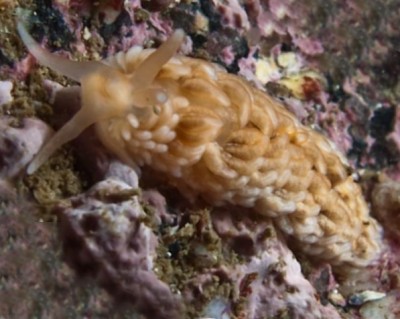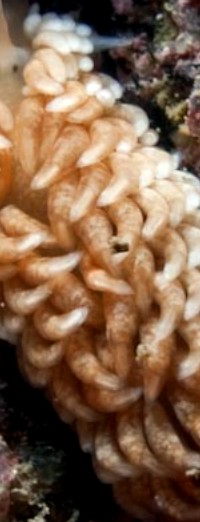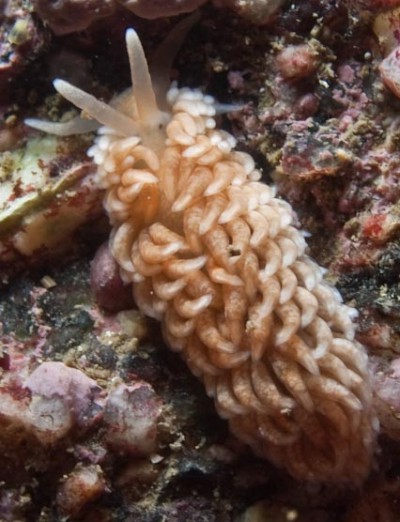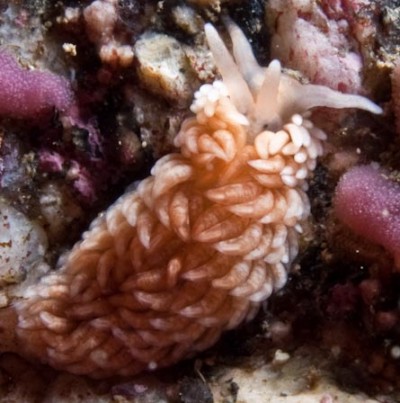Aeolidiella glauca? from northwest Spain
November 30, 2009
From: Jose Garcia Santiago

Hi Bill:
I've discovered your site weeks ago and I'm very enthusiastic about it. Here are some photos of a slug that might be Aeolidiella glauca, but I'm not completely sure.
I took this specimen home and kept it for some days for observation and could observe a curious thing. On two occasions the animal secreted like a silk filament as if it was a spider and hung from this structure. The first time was just when I got home, and it remained hanging from the top of the glass bottle in which I had kept it. The second time was more than a week later, after changing the water of the container. Then I put a fucus algae into the bottle and the silk fiber was hung from it. This filament was created from the pointed tail of the animal.
Locality: Ría de Arosa, Ribeira, about 10 meters, La Coruña, Spain, Atlantic coast, 7 november 2009, rock floor under a rocky vertical wall onto which there were some Actinia equina. The animal was stuck into an empty mussel shell.. Length: about 15-20 mm. Photographer: Jose Garcia Santiago
Have you ever seen or heard something like this?.
Congratulations for your site.
Jose Garcia Santiago
josegarciasantiago@gmail.com



Dear José,
European species of Aeolidiella are quite difficult to identify from photos unless their very special characters can be seen [see Bernard Picton's message #3845]. For example A. alderi is easy to identify when the first row of cerata are white, but sometimes it is hard to tell. In your animal the first row of cerata certainly appear to be quite whitish but on looking closely I am pretty sure there is brown digestive gland pigment visible in some of the larger cerata, which suggests it is not A. alderi. Bernard Picton says that a good character of A. glauca is the pale whitish pigment patches on the cerata which we can certainly see in your photos. On those grounds I think we can be fairly confident that this is A. glauca.
In Cervera et al (2006) A. glauca is recorded from Portugal, Straits of Gibraltar and the Mediterranean coast of Spain but not from the Atlantic coast of nthn Spain, so this may be a new, if not unexpected, record.
Concerning the 'spider-like' thread. All sea slugs produce a mucus which helps them crawl along, much like the slime trail in land snail. The mucus is produced by special gland cells in the base of the foot. Some have uniform gland cells and others have a special glandular region. I am not sure if Aeolidiella glauca has specialised region. Some species, especially those living in places with large water movement can produce a particularly sticky mucus which they use - much like a mountain climber's safety rope - to stay attached to the substrate. Sometimes when on algae or at the end of a rock they will suspend themselves in the water on their sticky mucus much as you describe. It allows them to go 'adventuring' always with the chance of getting back to safety.
Best wishes,
Bill Rudman
Related messages
-
Aeolidiella glauca - feeding observations
From: Mike Noren, November 26, 2002 -
Aeolidiella glauca f rom Sweden
From: Mike Noren, December 17, 2001 -
Aeolidiella glauca from Holland
From: Peter H. van Bragt, September 6, 1999
